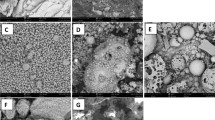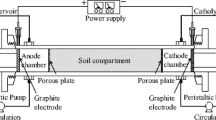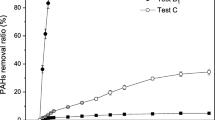Abstract
Petroleum hydrocarbon, a complex mixture including aliphatic and aromatic hydrocarbons, is known to have negative effects on the environment. We determined the effectiveness of persulfate (PS) (5% w/w) activated using 1% (w/w) of various types of soil minerals, goethite (α-FeOOH), hematite (Fe2O3), magnetite (Fe3O4), maghemite (γ- Fe2O3), manganese oxide (MnO2), and zeolite (clinoptilolite) to treat petroleum hydrocarbon-contaminated soil. Total petroleum hydrocarbon (TPH) was 4200 ± 124 mg kg−1. The TPH removal efficiency was in the order: Fe3O4 > MnO2 > γ-Fe2O3 > Fe2O3 > α-FeOOH > clinoptilolite. When the PS dosage and the moisture content of the soil increased, the degradation rate (k obs) of TPH removal increased; on the other hand, lowering the pH increased the k obs of TPH removal. The PS oxidation of TPH was optimized using response surface methodology (RSM). The interactive effects of three factors, namely, persulfate dosage (X 1), pH (X 2), and soil moisture content (X 3), were investigated. The optimum removal of TPH by PS oxidation activated using 1% (w/w) magnetite was obtained at 5.5% (w/w) PS and 85% (w/w) moisture content at an initial pH of 4.5. However, the soil treated by PS showed a negative effect on soil health. The germination of mung bean (Vigna radiata (L.) R. Wilczek) and the CO2 release for the treated soil were low, indicating that toxicity had occurred in the treated soil. To restore the treated soil, adding a soil amendment, like CaCO3, fly ash, or crop residue, was able to improve plant growth and soil microbial activity.









Similar content being viewed by others

References
Achugasim, D., Osuji, L. C., & Ojinnaka, C. M. (2011). Use of activated persulfate in the removal petroleum hydrocarbons from crude oil polluted soil. Research Journal of Chemical Science, 1(7), 57–67.
Adesodun, J. K., & Mbagwu, J. S. C. (2008). Biodegradation of waste-lubricating petroleum oil in a tropical alfisol as mediated by animal droppings. Bioresource Technology, 99, 5659–5665.
Ahmad, M., Teel, A. L., & Watts, R. J. (2010). Persulfate activation by subsurface minerals. Journal of Contaminant Hydrology, 115, 34–45.
Andrade, L. N., Araujo, S. F., Matos, A. T., Henriques, A. B., Oliveira, L. C., Souza, P. P., Chagas, P., Leao, M. M. D., & Amorim, C. C. (2017). Performance of different oxidants in the presence of oxisol: remediation of groundwater contaminated by gasoline/ethanol blend. Chemical Engineering Journal, 308, 428–437.
Assaf, N. A., & Turco, R. F. (1994). Influence of carbon and nitrogen application on the mineralization of atrazine and its metabolites in soil. Pesticide Science, 41(1), 41–47.
Balba, M. T., Al-Awadhi, N., & Al-Daher, R. (1998). Bioremediation of oil-contaminated soil: Microbiological methods for feasibility assessment and field evaluation. Journal of Microbiology Methods, 32, 155–164.
Bayat, M., Sohrabi, M., & Royaee, S. J. (2012). Degradation of phenol by heterogeneous Fenton reaction using Fe/clinoptilolite. Journal of Industrial and Engineering Chemistry, 18(3), 957–962.
Bezerra, M. A., Santelli, R. E., Oliveira, E. P.,Villar, L. S., & Escaleira, L. A. (2008). Response surface methodology (RSM) as a tool for optimization in analytical chemistry. Talanta, 76, 965–977.
Brohon, B., Delolme, C., & Gourdon, R. (2001). Complementarity of bioassays and microbial activity measurement for the evaluation of hydrocarbon-contaminated soil quality. Soil Biology and Biochemistry, 33, 883–891.
Büyüksönmez, F., Hess, T. F., Crawford, R. L., & Watts, R. J. (1998). Toxic effects of modified Fenton reactions on Xanthobacter flavus FB71. Applied Environmental Microbiology, 64, 3759–3764.
Chien, Y. C. (2012). Field study of in situ remediation of petroleum hydrocarbon contaminated soil on site using microwave energy. Journal of Hazardous Materials, 199–200, 457–461.
Chokejaroenrat, C., Sakulthaew, C., Satapanajaru, T., Tikhamram, T., Pho-Ong, A., & Mulseesuk, T. (2015). Treating methyl orange in a two-dimensional flow tank by in situ chemical oxidation using slow-release persulfate activated with zero-valent iron. Environmental Engineering Science, 32, 1007–1015.
Cornell, R. M., Posner, A. M., & Quirk, J. P. (1976). Kinetics and mechanisms of the acid dissolution of goethite (α-FeOOH). Journal of Inorganic Nuclear Chemistry, 38, 563–567.
Corseuil, H. X., Kaipper, B. I. A., & Fernandes, M. (2004). Cosolvency effect in subsurface systems contaminated with petroleum hydrocarbons and ethanol. Water Research, 38, 1449–1456.
Do, S.-H., Kwon, Y. J., & Kong, S.-H. (2010). Effect of metal oxides on the reactivity of persulfate/Fe(II) in the remediation of diesel-contaminated soil and sand. Journal of Hazardous Materials, 182(1–3), 933–936.
Dong, Z.-Y., Huang, W.-H., Xing, D.-F., & Zhang, H. F. (2013). Remediation of soil co-contaminated with petroleum and heavy metals by the integration of electrokinetics and biostimulation. Journal of Hazardous Materials, 260(15), 399–408.
Farzadkia, M., Dehghani, M., & Moafian, M. (2014). The effects of Fenton process on the removal of petroleum hydrocarbons from oily sludge in Shiraz oil refinery, Iran. Journal of Environmental Health Science and Engineering, 12(31), 1–7.
Fu, J., Zhao, Y., & Wu, Q. (2007). Optimising photoelectrocatalytic oxidation of fulvic acid using response surface methodology. Journal of Hazardous Materials, 144, 499–505.
Ghafari, S., Aziz, H. A., Isa, M. H., & Zinatizadeh, A. A. (2009). Application of response surface methodology (RSM) to optimize coagulation-flocculation treatment of leachate using poly-aluminum chloride (PAC) and alum. Journal of Hazardous Materials, 163, 650–656.
Hentati, O., Lachhab, R., Ayadi, M., & Ksibi, M. (2013). Toxicity assessment for petroleum-contaminated soil using terrestrial invertebrates and plant bioassays. Environmental Monitoring Assessment, 185(4), 2989–2998.
Kakosová, E., Hrabák, P., Černík, M., Novotný, V., Czinnerová, M., Trögl, J., Popelka, J., Kuráň, P., Zoubková, L., & Vrtoch, Ľ. (2017). Effect of various chemical oxidation agents on soil microbial communities. Chemical Engineering Journal, 314, 257–265.
Kong, S.-H., Watts, R. J., & Choi, J.-H. (1998). Treatment of petroleum-contaminated soils using iron mineral catalyzed hydrogen peroxide. Chemosphere, 37, 1473–1482.
Korablev, V. V., Chechevichkina, A. V., Boricheva, I. K., & Samonin, V. V. (2017). Structure and morphological properties of clinoptilolite modified by manganese dioxide. St. Petersburg Polytechnical University Journal: Physics and Mathematics, 3(1), 63–70.
Liang, C., Wang, Z.-S., & Bruell, C. J. (2007). Influence of pH on sulfate oxidation of TCE at ambient temperatures. Chemosphere, 66, 106–113.
Liang, C., Huang, C.-F., & Chen, Y.-J. (2008). Potential for activated persulfate degradation of BTEX contamination. Water Research, 42, 4091–4100.
Lu, M., Zhang, Z., Qiao, W., Wei, X., Guan, Y., Ma, Q., & Guan, Y. (2010). Remediation of petroleum-contaminated soil after composting by sequential treatment with Fenton-like oxidation and biodegradation. Bioresource Technology, 101(7), 2106–2113.
McCormick, L. L., & Hiltbold, A. E. (1996). Microbiological decomposition of atrazine and diuron is soil. Weeds, 14(1), 77–82.
Myers, R. H., Montgomery, D. C., & Anderson-Cook, C. M. (2016). Response surface methodology: process and product optimization using designed experiments. New Jersey: John Wiley & Sons, Inc.
Nam, K., Rodriguez, W., & Kukor, J. J. (2001). Enhanced degradation of polycyclic aromatic hydrocarbons by biodegradation combined with a modified Fenton reaction. Chemosphere, 45, 11–20.
Nelson, D. W., & Sommers, L. E. (1982). Total carbon, organic carbon and organic matter. In A. L. Page, R. H. Miller, & D. R. Keeney (Eds.), Methods of soil analysis. Part 2: Chemical and microbiological properties, second edition (pp. 539–579). Wisconsin: American Society of Agronomy, Inc. and Soil Science Society of America, Inc.
Niu, C.-G., Wang, Y., Zhang, X.-G., Zeng, G.-M., Huang, D.-W., Ruan, M., & Li, X.-W. (2012). Decolorization of an azo dye Orange G in microbial fuel cells using Fe(II)-EDTA catalyzed persulfate. Bioresource Technology, 126, 101–106.
OECD (Organization for Economic Co-operation and Development). (2000). OECD Guideline for the testing of chemical-Test No. 217: Soil Microorganism: Carbon Transformation Test. http://lysander.sourceoecd.org/vl=4422191/cl=12/nw=1/rpsv/cgi-bin/fulltextew.pl?prpsv=/ij/oecdjournals/1607310x/v1n2/s18/p1.idx. Accessed 15 Mar 2017.
Office of Environmental Health Hazard Assessment. (2009). Soil toxicity and bioassessment test methods for ecological risk assessment: toxicity test methods for soil microorganisms, terrestrial plants, terrestrial invertebrates and terrestrial vertebrates. https://oehha.ca.gov/media/downloads/ecotoxicology/document/soiltox120208.pdf. Accessed 15 March 2017.
OECD (Organization for Economic Co-operation and Development). (2006). OECD Guideline for the testing of 10.1007/s11270-017-3527-xchemical-Test No. 227: Terrestrial Plant Test: Vegetative Vigour Test. http://www.oecdilibraly.org/docserver/download/fulltext/9722701e.pgf?expires=1304153148&id=id&;accname=freeContent&checksum=BBB4D858F6317395106D565C204AD204. Accessed 15 March 2017.
Oplinger, E. S., Hardman, L. L., Kaminski, A. R., Combs, S. M., & Doll, J. D. (2017). Mungbean. http://corn.agronomy.wisc.edu/Crops/Mungbean.aspx. Accessed 28 Apr 2017.
Österreicher-Cunha, P., Vargas Jr., E. D. A., Guimarães, J. R. D., Laga, G. P., Antunes, F. D. S., & Silva, M. I. P. D. (2009). Effect of ethanol on the biodegradation of gasoline in an unsaturated tropical soil. International Biodeterioration & Biodegradation, 63, 208–216.
Pariona, N., Martínez, A. I., Hernandez-Flores, H., & Clark-Tapia, R. (2017). Effect of magnetite nanoparticles on the germination and early growth of Quercus macdougallii. Science of the Total Environment, 575, 869–875.
Reeser, L. G., Acra, A. P. L., & Lee, T. (1995). Covering solar energy into liquid fuels. Resource Engineering & Technology for a Sustainable World, 2(1), 8–11.
Rhoades, J. D. (1982). Total carbon, organic carbon and organic matter. In A. L. Page, R. H. Miller, & D. R. Keeney (Eds.), Methods of soil analysis. Part 2: chemical and microbiological properties, second edition (pp. 149–157). Wisconsin: American Society of Agronomy, Inc. and Soil Science Society of America, Inc.
Richardson, S. D., Lebron, B., Miller, C. T., & Aitken, M. D. (2009). Effects of persulfate oxidation on microbial activity and PAH removal in contaminated soil from a manufactured-gas plant site. In Situ and On-Site Bioremediation: https://uncch.pure.elsevier.com/en/publications/effects-of-persulfate-oxidation-on-microbial-activity-and-pah-rem. Accessed 15 March 2017.
Sabour, M. R., & Amiri, A. (2017). Comparative study of ANN and RSM for stimultaneous optimization of multiple targets in Fenton treatment of landfill leachate. Waste Management, 65, 54–62.
Satapanajaru, T., Yoo-iam, M., Bongprom, P., & Pengthamkeerati, P. (2015). Decolorization of reactive black 5 by persulfate oxidation activated by ferrous ion and its optimization. Desalination and Water Treatment, 56(1), 121–135.
Sentenac, P., Lynch, R. J., Bolton, M. D., & Taylor, R. N. (2007). Alcohol’s effect on the hydraulic conductivity of consolidated clay. Environmental Geology, 52, 1595–1600.
Sidhu, P. S., Gilkes, R. J., Cornell, R. M., Posner, A. M., & Quirk, J. P. (1981). Dissolution of iron oxides and oxyhydroxides in hydrochloric and perchloric acids. Clays and Clay Minerals, 29(4), 269–276.
Smith, E., Thavamani, P., Ramadass, K., Naidu, R., Srivastava, P., & Megharaj, M. (2015). Remediation trials for hydrocarbon-contaminated soils in arid environments: evaluation of bioslurry and biopiling techniques. International Biodeterioration & Biodegradation, 101, 56–65.
Sra, K. S., Thomson, N. R., & Barker, J. F. (2013). Persulfate injection into a gasoline source zone. Journal of Contaminant Hydrology, 150, 35–44.
Tang, J., Wang, R., Niu, X., & Zhou, Q. (2010). Enhancement of soil petroleum remediation by using a combination of ryegrass (Lolium perenne) and different microorganisms. Soil and Tillage Research, 110(1), 87–93.
Tang, J., Wang, M., Wang, F., Sun, Q., & Zhou, Q. (2011). Eco-toxicity of petroleum hydrocarbon contaminated soil. Journal of Environmental Science (China), 23(5), 845–851.
Tang, X., Hashmi, M. Z., Zeng, B., Yang, J., & Shen, C. (2015). Application of iron-activated persulfate oxidation for the degradation of PCBs in soil. Chemical Engineering Journal, 279, 673–680.
Teel, A. L., Cutler, L. M., & Watts, R. J. (2009). Effect of sorption on contaminant oxidation in activated persulfate systems. Journal of Environmental Science Health: Part A Toxic/Hazard Substance Environmental Engineering, 44(11), 1098–1103.
Tsitonaki, A., Smets, B. F., & Bjerg, P. L. (2008). Effects of heat-activated persulfate oxidation on soil microorganisms. Water Research, 45(4–5), 1013–1022.
Ugwoha, E., & Andreson, J. M. (2014). Sorption and phase distribution of ethanol and butanol blended gasoline vapours in the vadose zone after release. Journal of Environmental Sciences, 26, 608–616.
Usman, M., Faure, P., Hanna, K., Abdelmoula, M., & Ruby, C. (2012). Application of magnetite catalyzed chemical oxidation (Fenton-like and persulfate) for the remediation of oil hydrocarbon contamination. Fuel, 96, 270–276.
Usman, M., Hanna, K., & Haderlein, S. (2016). Fenton oxidation to remediate PAHs in contaminated soils: a critical review of major limitations and counter-strategies. Science of the Total Environment, 569–570, 179–190.
Wagner, G. H., & Chahal, K. S. (1996). Decomposition of carbon-14 labelled atrazine in soil samples from Sanborn field 1. Soil Science Society of America Journal, 30(6), 752–754.
Xu, X.-R., Li, S., Hao, Q., Liu, J.-L., Yu, Y.-Y., & Li, H. B. (2012). Activation of Persulfate and its environmental application. International Journal of Environment and Bioenergy, 1(1), 60–81.
Yen, C.-H., Chen, K.-F., Kao, C.-M., Liang, S.-H., & Chen, T.-Y. (2011). Application of persulfate to remediate petroleum hydrocarbon-contaminated soil: feasibility and comparison with common oxidants. Journal of Hazardous Materials, 186, 2097–2102.
Acknowledgements
This research was supported by the Kasetsart University Research and Development Institute (KURDI). We thank the Department of Environmental Technology and Management, Faculty of Environment for the research space and for supplying the instrumentation. We also thank Miss Pornpun Lertkitmungkong for assisting in the research.
Author information
Authors and Affiliations
Corresponding author
Rights and permissions
About this article
Cite this article
Satapanajaru, T., Chokejaroenrat, C., Sakulthaew, C. et al. Remediation and Restoration of Petroleum Hydrocarbon Containing Alcohol-Contaminated Soil by Persulfate Oxidation Activated with Soil Minerals. Water Air Soil Pollut 228, 345 (2017). https://doi.org/10.1007/s11270-017-3527-x
Received:
Accepted:
Published:
DOI: https://doi.org/10.1007/s11270-017-3527-x



